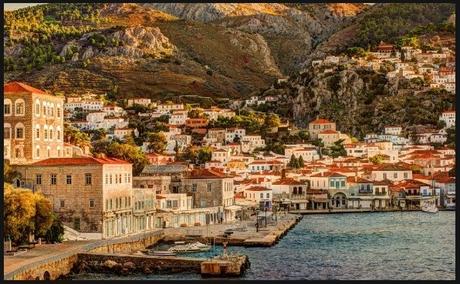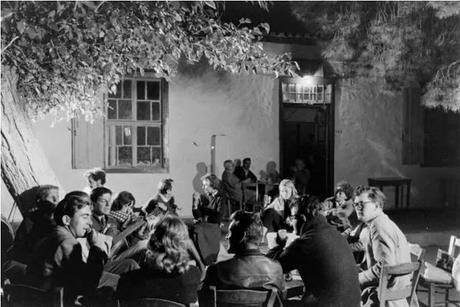
the harbor and 'amphitheatre' of Hydra town, 1955
It is also just a couple of hours by ferry from Athens, quite a lot of Athenians have second homes there, and it also has an extension of the Athenian School of Art, which might explain why it became a hub for international artists and writers after the second world war, people looking to 'get away from' the rat race and the crushing social conservatism of those immediate post war/cold war years, to 'get away to' somewhere they could be a little more bohemian, where there was good light, plenty of sunny days, and where house rents and the cost of living were cheap by comparison - an out of the way but still accessible idyll where they could pursue their unconventional lifestyles and creative calling - cue Hydra.The Australian couple George Johnston and Charmian Clift along with their children were the first to establish a long-term presence and they lived on the island from 1955 to 1964. Their writings and network of friends attracted others from the antipodes to live and write or paint on Hydra, but other nationalities discovered it as well; American beats like Gregory Corso, northern Europeans such as Axel Jensen and his wife Marianne Ihlen, Paolo and Magda Tilche, David and Angela Goschen and Klaus Merkel. Perhaps the most famous of all, and the main reason for Hydra's lasting fame as an artistic colony, was Leonard Cohen who arrived there at the beginning of 1960. He swapped cold, snowy Montreal for a Greek island on a whim, but fell in love with the place and so when he was left a sum of money by a relative, Cohen was able to buy a dilapidated house on Hydra, not just rent it. He had it refurbished simply in tehe local style and his family owns it to this day.
The artistic colony of ex-pats in Hydra town lived hand-to-mouth and in each others pockets, houses, beds, novels. They were close-knit but not always harmonious. In summer the living was easy, lots of sun, sex, olives, retsina and a little writing (though occasionally the water supply and the electricity failed). In winter it was tough-going, cold and cut off from the world on their rock in the Aegean. The novelists would bash away on their typewriters before sending their manuscripts off into the world via the ferry, then waiting anxious weeks for a cheque, or more likely another rejection slip. The artists would paint when the light and their cold fingers allowed, storing up canvases they hoped to sell to summer visitors. And always there was intrigue and infighting.
It was on Hydra that Axel Jensen ran off with an American painter and Marianne Ihlen fell into Leonard Cohen's arms, moving in with him as his muse and lover for some considerable time (check out the back cover of Cohen's second LP 'Songs From A Room'). It was on Hydra that Cohen finished his first novel 'The Favourite Game' and wrote his second, 'Beautiful Losers'. It was also on Hydra, outside the local tavernas on long, hot summer evenings, that Cohen armed with his guitar gradually made the transformation from poet and novelist to song-writer and singer extraordinaire.

Leonard Cohen (with guitar) entertaining outside Douskos taverna, Hydra 1960
He never made a living from his poetry or novels and though he claimed he never had faith in the sound of his voice, it was on that island that he was persuaded he had a talent for writing and singing from the heart - and the cliched rest is history. In fact his sojourn on Hydra was the catalyst for many of his great early songs (from a room), including 'So Long, Marianne' and 'Bird On A Wire' - which only became possible the year the Greek telephone company installed telephone lines on the island, connecting Hydra with mainland Greece and the wider world.By the mid-1960s most of the core of artists on Hydra realised that the only way to properly further their careers was to follow their work out into that wider world, which by then was becoming more bohemian like them anyway. And then came the military coup of 1967. But with the deaths of Marianne Ihlen and Leonard Cohen within weeks of each other in 2016, interest in their tangled lives and those of their colony of Hydra friends has been reawakened, and it is a revisiting that I found pays dividends - see the bibliography later on.
I offer two poems again this week. The first is by one of finest Greek poets of the 20th century, Konstantinos Kavafis. Although written in 1924, it could almost be about Leonard and Marianne, so prescient does it sound.
Before Time Altered ThemThey were full of sadness at their parting.They hadn't wanted it: circumstances made it necessary.The need to earn a living forced one of themto go far away - New York or Canada.The love they felt wasn't, of course, what it once had been;the attraction between them had gradually diminished,the attraction had diminished a great deal.But to be separated, that wasn't what they wanted.It was circumstances. Or maybe Fateappeared as an artist and decided to part them now,before their feeling died out completely,before Time altered them:the one seeming to remain for the other what he always was,the good-looking young man of twenty-four.
The second is the latest from the imaginarium. It touches on the darker explanation behind the original 'fashion' for the predominance of white and that special blue, colours that many Greek island houses display to this day. It also supposes an act of civil disobedience.
Incidentally, the original reason that houses were decked in colours was because most were built of stone, usually volcanic and dark. In order to keep them cooler in the very hot summers, they were plastered and lime-washed (ground limestone mixed with water - paint being either expensive of simply unavailable). Sometimes they were white-washed but often other pigments were mixed in with the lime, permitting a palette of pale, sun-reflecting colours: ochre houses as well as pink, green, lilac and sky-blue. Then came the military coups of 1935 and 1967.
Loulaki BluesThe King is fled, long live the King,though don't let anyone connected to theMinistry of Public Order hear you saying so.
Whites over time tend to yellow or gray.We restored the illusion in the launderingby adding a washing blue, Loulaki on Hydra.
Blue and yellow are complementariesin the subtractive color model, for that ishow the science works. But now a new edict
is being enforced across the islands suchthat only white and blue must be the huesof every house: white walls, blue woodwork,
roofs of the same cerulean, to be attainedby mixing our Loulaki washing powder inwith the standard calcimine slaked whitewash.
It is regimentation designed to signalresurgence of a nation, the Third Hellenicuniform, pretty as a picture to all appearances
but our souls within, ferric with mute fury,so we wilfully allow our shirts and blousesto fade to yellow or gray. They'll stay that way
until the moment we are free from thismonstrous tyranny of Generals. Our clothes become us, symbols of resistance and of hurt,
degrading as months of heat and povertyroll by. No mojo hands will deliver us fromthe uncivil prying of their eyes but iron will win.
The King is fled, long live the King.Fascism lives in white as much as black.These days, we don't trust men in brilliant shirts.

loulaki powder
If you're interested in following up on any of the Hydra creatives or the story of their time in Greece half a century or more ago, I can recommend the following:'Marianne & Leonard: Words Of Love' is a 90 minute documentary film by Nick Broomfield about Leonard Cohen, Marianne Ihlen, featuring much archive footage and interviews down the years.'Half The Perfect World' (sub-titled 'Writers, Dreamers and Drifters on Hydra 1955-1964') is an in-depth account of the people and the times by a couple of Australian academics, Paul Genoni and Tanya Dalziel, and is the go-to factual account of that ex-pat colony. It also includes many of James Burke's contemporary photographs.'Mermaid Singing' and 'Peel Me A Lotus' are Charmian Clift's immensely readable accounts of life on Kalymnos and Hydra respectively and are due to be reissued in April.'The Water and the Wine' by Tamar Hodes is one of a number of fictionalised accounts of that artistic community, this time by someone who had lived on Hydra as a child at the time.'A Theatre For Dreamers' by Polly Samson is the latest in the line of novels based around the cast of artists and their friends living on Hydra in the early 1960s. Currently available in hardback, it is due for its paperback release in April (tying in with the Clift re-issues, for which Samson has written introductions.The last words (sung in this case) should probably go to Leonard Cohen himself. Click on song title to activate the link through to: So Long, Marianne
Thanks for reading, S ;-)
Email ThisBlogThis!Share to TwitterShare to Facebook
